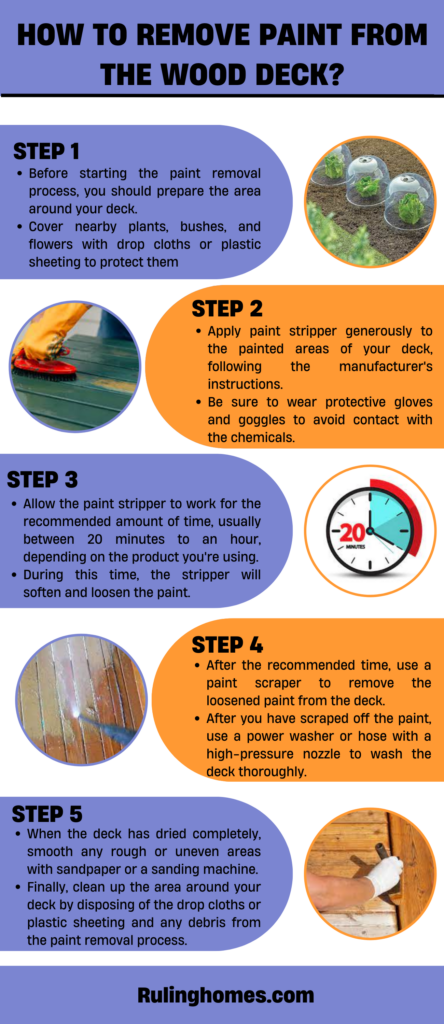Removing paint from a wood deck can be a time-consuming task, but it is necessary if you want to restore the natural beauty of your deck. Here is a step-by-step guide on how to remove paint from a wood deck:
Things you need while removing the paint from the wood deck:
- Paint stripper
- Paint scraper
- Power washer or hose with high-pressure nozzle
- Sandpaper or sanding machine
- Protective gloves and goggles
- Drop cloths or plastic sheeting
Step 1
Before starting the paint removal process, you should prepare the area around your deck. Cover nearby plants, bushes, and flowers with drop cloths or plastic sheeting to protect them from any chemicals or debris that may come off during the process.
Step 2
Apply paint stripper generously to the painted areas of your deck, following the manufacturer’s instructions. Be sure to wear protective gloves and goggles to avoid contact with the chemicals.
Step 3
Allow the paint stripper to work for the recommended amount of time, usually between 20 minutes to an hour, depending on the product you’re using. During this time, the stripper will soften and loosen the paint.
Step 4
After the recommended time, use a paint scraper to remove the loosened paint from the deck. Begin at one end of the deck and work your way to the other, scraping off as much paint as possible.
Step 5
After you have scraped off the paint, use a power washer or hose with a high-pressure nozzle to wash the deck thoroughly. This will remove any remaining paint and stripper residue.
Step 6
Once the deck has dried completely, use sandpaper or a sanding machine to smooth out any rough or uneven areas where the paint was removed. This will prepare the deck for refinishing or staining.
Step 7
Finally, clean up the area around your deck by disposing of the drop cloths or plastic sheeting and any debris from the paint removal process.
Here are some of the important considerations while removing the paint from wood deck
Safety first: Always wear protective gloves and goggles when using paint strippers, scrapers, or sanders to avoid any potential contact with chemicals or flying debris.
Choose the right paint stripper: Choose a paint stripper that is specifically designed for use on wood and is appropriate for the type of paint you are trying to remove. Read the instructions and safety precautions on the product label before use.
Test a small area first: Before applying the paint stripper to the entire deck, test it on a small, inconspicuous area to make sure it doesn’t damage or discolor the wood.
Don’t rush: Give the paint stripper enough time to work according to the manufacturer’s instructions. Rushing the process may result in incomplete removal or damage to the wood.
Proper disposal: Paint stripper, scrapings, and any other waste generated during the paint removal process should be disposed of properly, following local regulations and guidelines.
Protect surrounding areas: Cover nearby plants, bushes, and flowers with drop cloths or plastic sheeting to protect them from any chemicals or debris that may come off during the process.
Consider professional help: If you are unsure about the process or don’t have the right tools, it may be best to hire a professional to handle the paint removal process.
Conclusion
Removing paint from a wood deck can be a time-consuming process, but it is necessary to restore the natural beauty of the wood.
By following the steps outlined in the guide, you can safely and effectively remove paint from your deck.
It is important to keep in mind the considerations mentioned, such as choosing the right paint stripper, testing a small area first, and wearing protective gear.
With patience and attention, you can achieve a clean, paint-free deck that is ready for refinishing or staining. Also, learn to paint the wood deck in the right way to avoid its removal.

I grew up on a small farm in New Jersey. We had a big family because my parents, my uncles and aunties all were living together on this farm so, you can imagine, it was always over crowded with people. But living in farm was really great because we had to do everything on our own and I learned so many things from my parents and uncles and aunties and that is where I found my passion for fixing things, whether it is renovating or designing, I was always there. Read more

